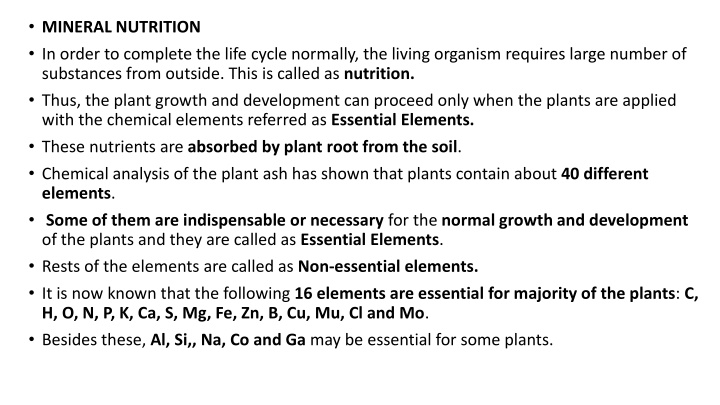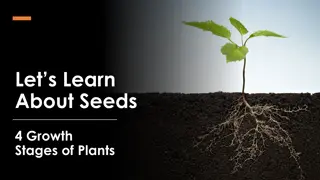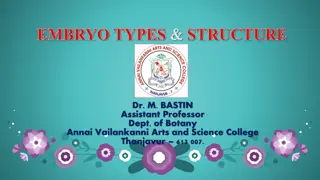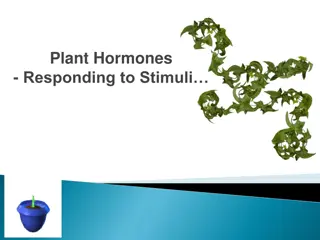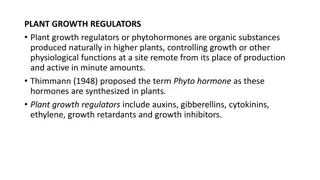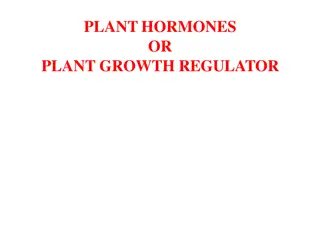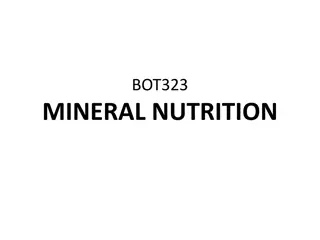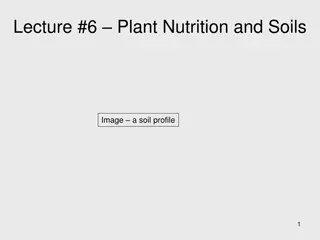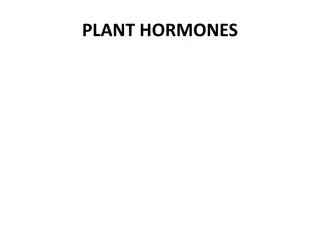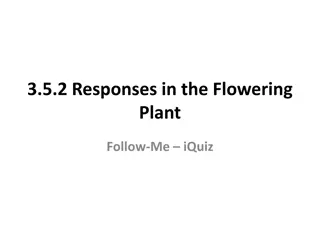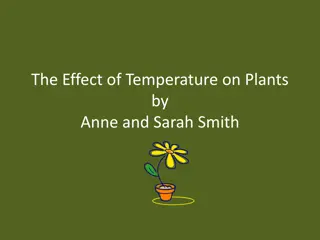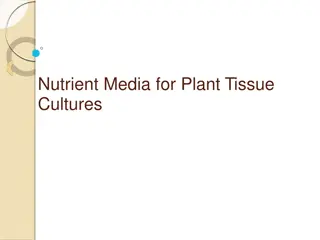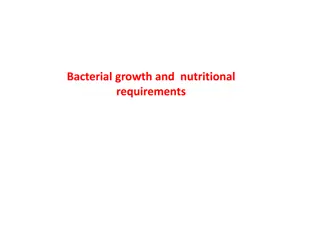Essential Elements for Plant Growth: A Comprehensive Nutritional Guide
Plants require essential elements for normal growth and development, with 16 key elements identified as crucial. Macronutrients and micronutrients play vital roles in plant metabolism, with specific criteria determining the essentiality of each element. Understanding the diverse functions of these elements is essential for optimizing plant health and productivity.
Download Presentation

Please find below an Image/Link to download the presentation.
The content on the website is provided AS IS for your information and personal use only. It may not be sold, licensed, or shared on other websites without obtaining consent from the author.If you encounter any issues during the download, it is possible that the publisher has removed the file from their server.
You are allowed to download the files provided on this website for personal or commercial use, subject to the condition that they are used lawfully. All files are the property of their respective owners.
The content on the website is provided AS IS for your information and personal use only. It may not be sold, licensed, or shared on other websites without obtaining consent from the author.
E N D
Presentation Transcript
MINERAL NUTRITION In order to complete the life cycle normally, the living organism requires large number of substances from outside. This is called as nutrition. Thus, the plant growth and development can proceed only when the plants are applied with the chemical elements referred as Essential Elements. These nutrients are absorbed by plant root from the soil. Chemical analysis of the plant ash has shown that plants contain about 40 different elements. Some of them are indispensable or necessary for the normal growth and development of the plants and they are called as Essential Elements. Rests of the elements are called as Non-essential elements. It is now known that the following 16 elements are essential for majority of the plants: C, H, O, N, P, K, Ca, S, Mg, Fe, Zn, B, Cu, Mu, Cl and Mo. Besides these, Al, Si,, Na, Co and Ga may be essential for some plants.
Criteria for Essentiality The criteria for essentiality of an element are given below: (a) The element must be absolutely necessary for supporting normal growth and reproduction. In the absence of the element the plants do not complete their life cycle or set the seeds. (b) The requirement of the element must be specific and not replaceable by another element. In other words, deficiency of any one element cannot be met by supplying some other element. (c) The element must be directly involved in the metabolism of the plant.
Macronutrients are generally present in plant tissues in large amounts (in excess of 10 mmole Kg 1 of dry matter). The macronutrients include carbon, hydrogen, oxygen, nitrogen, phosphorous, sulphur, potassium, calcium and magnesium Of these, carbon, hydrogen and oxygen are mainly obtained from CO2 and H2O, while the others are absorbed from the soil as mineral nutrition
Micronutrients or trace elements, are needed in very small amounts (less than 10 mmole Kg 1 of dry matter). These include iron, manganese, copper, molybdenum, zinc, boron, chlorine and nickel. In addition to the 17 essential elements named above, there are some beneficial elements such as sodium, silicon, cobalt and selenium. They are required by higher plants.
Essential elements can also be grouped into four broad categories on the basis of their diverse functions. These categories are: (i) Essential elements as components of biomolecules and hence structural elements of cells (e.g., carbon, hydrogen, oxygen and nitrogen). (ii) Essential elements that are components of energy-related chemical compounds in plants (e.g., magnesium in chlorophyll and phosphorous in ATP).
(iii) Essential elements that activate or inhibit enzymes, for example Mg2+ is an activator for both ribulose bisphosphate carboxylaseoxygenase and phosphoenol pyruvate carboxylase, both of which are critical enzymes in photosynthetic carbon fixation; Zn2+ is an activator of alcohol dehydrogenase and Mo of nitrogenase during nitrogen metabolism. (iv) Some essential elements can alter the osmotic potential of a cell. Potassium plays an important role in the opening and closing of stomata.
Role of Macro- and Micro-nutrients Essential elements perform several functions. They participate in various metabolic processes in the plant cells such as permeability of cell membrane, maintenance of osmotic concentration of cell sap, electron transport systems, buffering action, enzymatic activity and act as major constituents of macromolecules and co-enzymes. Various forms and functions of essential nutrient elements are given below.
Nitrogen: This is the essential nutrient element required by plants in the greatest amount. It is absorbed mainly as NO3 though some are also taken up as NO2 or NH4+. Nitrogen is required by all parts of a plant, particularly the meristematic tissues and the metabolically active cells. Nitrogen is one of the major constituents of proteins, nucleic acids, vitamins and hormones. Phosphorus: Phosphorus is absorbed by the plants from soil as HPO4- 2 or H2PO4-. Phosphorus is a constituent of cell membranes, certain proteins, all nucleic acids and nucleotides, and is required for all phosphorylation reactions.
Potassium: It is absorbed as potassium ion (K+). In plants, this is required in more abundant quantities in the meristematic tissues, buds, leaves and root tips. Potassium helps to maintain an anion-cation balance in cells and is involved in protein synthesis, opening and closing of stomata, activation of enzymes and in the maintenance of the turgidity of cells.
Calcium: Plant absorbs calcium from the soil in the form of calcium ions (Ca2+). Calcium is required by meristematic and differentiating tissues. During cell division it is used in the synthesis of cell wall, particularly as calcium pectate in the middle lamella. It is also needed during the formation of mitotic spindle It accumulates in older leaves. It is involved in the normal functioning of the cell membranes. It activates certain enzymes and plays an important role in regulating metabolic activities.
Magnesium: It is absorbed by plants in the form of divalent Mg2+ It activates the enzymes of respiration, photosynthesis and are involved in the synthesis of DNA and RNA. Magnesium is a constituent of the ring structure of chlorophyll and helps to maintain the ribosome structure. Sulphur: Plants obtain sulphur in the form of sulphate (SO42 ). Sulphur is present in two amino acids cysteine and methionine and is the main constituent of several coenzymes, vitamins (thiamine, biotin, Coenzyme A) and ferredoxin.
Iron: Plants obtain iron in the form of ferric ions (Fe3+). It is required in larger amounts in comparison to other micronutrients. It is an important constituent of proteins involved in the transfer of electrons like ferredoxin and cytochromes. It is reversibly oxidized from Fe2+ to Fe3+ during electron transfer. It activates catalase enzyme, and is essential for the formation of chlorophyll.
Manganese: It is absorbed in the form of manganous ions (Mn2+). It activates many enzymes involved in photosynthesis, respiration and nitrogen metabolism. The best defined function of manganese is in the splitting of water to liberate oxygen during photosynthesis. Zinc: Plants obtain zinc as Zn2+ ions. It activates various enzymes, especially carboxylases. It is also needed in the synthesis of auxin. Copper: It is absorbed as cupric ions (Cu2+). It is essential for the overall metabolism in plants. Like iron, it is associated with certain enzymes involved in redox reactions and is reversibly oxidized from Cu+ to Cu2+.
Boron : It is absorbed as BO33or B4O7-2 Boron is required for uptake and utilization of Ca2+, membrane functioning, pollen germination, cell elongation, cell differentiation and carbohydrate translocation. Molybdenum: Plants obtain it in the form of molybdate ions (MoO22+). It is a component of several enzymes, including nitrogenase and nitrate reductase both of which participate in nitrogen metabolism. Chlorine: It is absorbed in the form of chloride anion (Cl ). Along with Na+ and K+, it helps in determining the solute concentration and the anion cation balance in cells. It is essential for the water-splitting reaction in photosynthesis, a reaction that leads to oxygen evolution.
Nutritional Disorders in Crops Low supply or complete absence of any of the essential elements will exhibit typical symptoms, which are specific to the particular elements(s). This condition is called as nutrient deficiency and the symptoms as deficiency symptoms. In absence or low supply of elements (deficiency), following common symptoms generally develop in the plants.
General Deficiency Symptoms 1. Chlorosis: It is a physiological disease that occurs due to deficiency of mineral elements. (eg. N, K. Mg, Fe, Zn, Mn, S). Leaves become abnormally yellow or white due to reduction of chlorophyll contents. 2. Mottling: It is a condition of plant surface marked with colored spots due to anthocyanin pigmentation (eg. due to deficiency of N, K, Mg, P, and S). 3. Necrosis: It refers to the patch of dead tissues, due to deficiency of K, Mg, Zn, Ca, Mo, Mn, Fe, or B. 4. Bronzing: Development of bronze/copper colour on the leaves and various parts (eg. K) 5. Die back: Collapse of growing tip, affecting the youngest leaves and buds (eg. K, Ca, B or Cu)
6. Scorching: Burning of tissues accompanied by light brown colour. (eg. K, Ca, B or Cu) 7. Firing: Burning of tissues accompanied with dark brown or reddish brown colour (eg. Mg) 8. Rosetting: Clustering of leaves due to reduced leaf size and shorter internodal distance (eg. Cu, K, Zn) 9. Distortion of leaves: Irregular shaping of leaves like cupping, twisting, hooking or curling and also wavy margins. Cupping: B or Mo Twisting / Hooking: Zn / Ca / B Curling: Ca, B or Zn Head distortion: Cu (rice), Mn (Sunflower) Wavy: Zn 10. Gummosis: Oozing out of cell sap in the form of gummy substance (eg. Cu as in coconut etc.)
